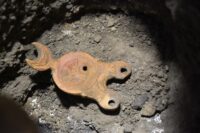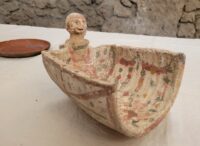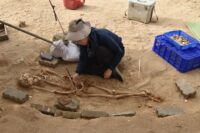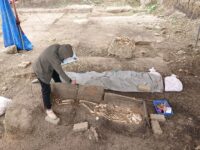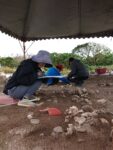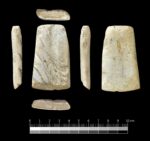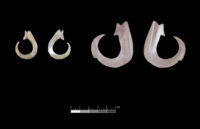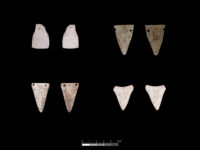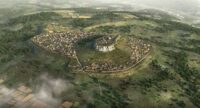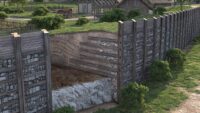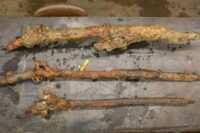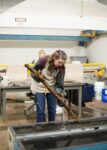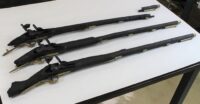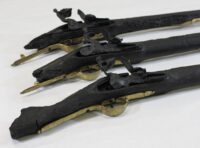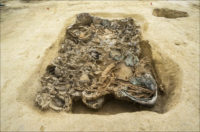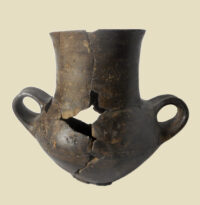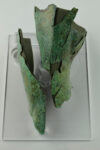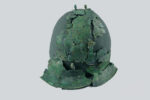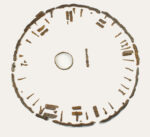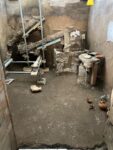 The latest discoveries in the excavation of Pompeii’s Regio V neighborhood are fully furnished utility spaces, of great archaeological significance for the details they preserve of a common domestic context in the 1st century Roman town.
The latest discoveries in the excavation of Pompeii’s Regio V neighborhood are fully furnished utility spaces, of great archaeological significance for the details they preserve of a common domestic context in the 1st century Roman town.
The room was found in the House of the Enchanted Garden, a beautifully frescoed home with a lararium (a shrine to the household gods) that is one of the largest ever discovered in Pompeii. In 2021, archaeologists undertook an excavation and restoration of rooms on the ground floor in front of the lararium and the stories above it. They uncovered four rooms, two on the ground floor and two above, that were furnished. One was unfinished, with unplastered walls and an earthen floor, a jarring contrast in a house so decorated with such fine frescoes. The unfinished room was used for storage.
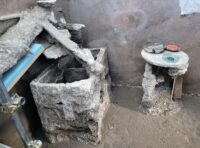 Archaeologists were able to make casts of the furnishings in the room which left a cavity in the hardened ash that could be filled with plaster. One room contained a bed frame and a pillow. The texture of the fabric was imprinted in the ash and is visible on the plaster cast. It is a very simple cot with ropes strung across the sides. There isn’t even a mattress, let along any decoration. Next to the bed was a wooden trunk divided into two compartments. The lid was open, but broken when the beams and floorboards of the story above collapsed in the eruption. Inside the trunk, archaeologists found a terra sigillata saucer and a double-spouted oil lamp depicting Zeus in the act of transforming into an eagle. Next to the trunk was a circular three-legged table with a shallow ceramic bowl containing two small glass bottles, a blue glass saucer and a terra sigillata bowl.
Archaeologists were able to make casts of the furnishings in the room which left a cavity in the hardened ash that could be filled with plaster. One room contained a bed frame and a pillow. The texture of the fabric was imprinted in the ash and is visible on the plaster cast. It is a very simple cot with ropes strung across the sides. There isn’t even a mattress, let along any decoration. Next to the bed was a wooden trunk divided into two compartments. The lid was open, but broken when the beams and floorboards of the story above collapsed in the eruption. Inside the trunk, archaeologists found a terra sigillata saucer and a double-spouted oil lamp depicting Zeus in the act of transforming into an eagle. Next to the trunk was a circular three-legged table with a shallow ceramic bowl containing two small glass bottles, a blue glass saucer and a terra sigillata bowl.
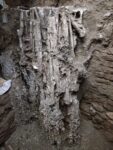 In the storage room, archaeologists were able to make two casts: a shelf and a group of wooden planks in different sizes, cuts and finishes, tied together. This was probably a collection of raw materials for assorted home maintenance projects from furniture patching to roof repair. Outside the room in a small hallway another utilitarian treasure was found: a tall wooden cabinet with at least four doors and five internal shelves. The top of the wardrobe and the front doors were damaged when the floor above the room collapsed. The remains of jugs, amphorae, bowls and plates were found on the damaged top shelf.
In the storage room, archaeologists were able to make two casts: a shelf and a group of wooden planks in different sizes, cuts and finishes, tied together. This was probably a collection of raw materials for assorted home maintenance projects from furniture patching to roof repair. Outside the room in a small hallway another utilitarian treasure was found: a tall wooden cabinet with at least four doors and five internal shelves. The top of the wardrobe and the front doors were damaged when the floor above the room collapsed. The remains of jugs, amphorae, bowls and plates were found on the damaged top shelf.
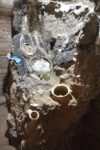 The excavation of the upper rooms revealed materials that were in the process of collapsing onto the rooms below. Of enormous archaeological value is a unique group of wax writing tablets. The group consists of seven triptychs tied both vertically and horizontally by a cord. A large cupboard, collapsed in the eruption, was also excavated. It contained different types of common use ceramics for kitchen and dining, as well as fine terra sigillata ceramics and glass. There was also a set of small bronze
The excavation of the upper rooms revealed materials that were in the process of collapsing onto the rooms below. Of enormous archaeological value is a unique group of wax writing tablets. The group consists of seven triptychs tied both vertically and horizontally by a cord. A large cupboard, collapsed in the eruption, was also excavated. It contained different types of common use ceramics for kitchen and dining, as well as fine terra sigillata ceramics and glass. There was also a set of small bronze 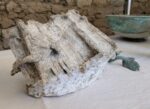 vessels, including a basin with palm leaf-shaped handles and a small jug decorated with a sphinx and lion’s head. Another special treasure is an incense burner shaped like a cradle with a male figure at one end. The polychrome paint coloring the figure and decorating the cradle with geometric designs is perfectly preserved.
vessels, including a basin with palm leaf-shaped handles and a small jug decorated with a sphinx and lion’s head. Another special treasure is an incense burner shaped like a cradle with a male figure at one end. The polychrome paint coloring the figure and decorating the cradle with geometric designs is perfectly preserved.
 The excavation overlapped onto a residential property behind the House of the Enchanted Garden, and there the plaster cast technique revealed the imprint of cane lathing in the mortar of a collapsed false ceiling. The cast shows the guts of Pompeiian construction: bundles of caning tied together by a thin cord and covered by a gauze-like fabric to separate the lathing from the wet mortar. Casts were also obtained of what appears to be wood paneling on the north, east and south walls of the room. Some are carved with coffered decoration; others are inlaid with delicate bone elements.
The excavation overlapped onto a residential property behind the House of the Enchanted Garden, and there the plaster cast technique revealed the imprint of cane lathing in the mortar of a collapsed false ceiling. The cast shows the guts of Pompeiian construction: bundles of caning tied together by a thin cord and covered by a gauze-like fabric to separate the lathing from the wet mortar. Casts were also obtained of what appears to be wood paneling on the north, east and south walls of the room. Some are carved with coffered decoration; others are inlaid with delicate bone elements.
